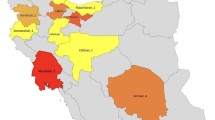Abstract
Introduction
The slow-channel congenital myasthenic syndrome (SCCMS) is a postsynaptic form of congenital myasthenic syndromes (CMSs), a clinically heterogeneous group of disorders caused by genetic defects leading to an abnormal signal transmission at the endplate.
Methods
We report clinical and molecular data of a multigenerational family in which the presentation of a progressive proximal-distal weakness with ocular involvement led to a number of different clinical diagnoses.
Results
A comprehensive genetic study which included whole-genome linkage analysis and whole-exome sequencing identified a heterozygous missense substitution (c.721C>T, p.L241F) in the ε subunit of the acetylcholine receptor (CHRNE) that was consistent with clinical weakness in all patients.
Discussion
SCCMS is characterized by a broad and heterogeneous clinical phenotype in which disease onset, symptoms, severity, and progression can be highly variable even between family members. The identification of a CHRNE mutation allowed to make the definitive diagnosis of CMS in this family and contributed to define the clinical spectrum of this disease.



Similar content being viewed by others
References
Beeson D (2016) Congenital myasthenic syndromes: recent advances. Curr Opin Neurol 29:565–571. https://doi.org/10.1097/WCO.0000000000000370
Abicht A, Dusl M, Gallenmüller C, Guergueltcheva V, Schara U, Della Marina A, Wibbeler E, Almaras S, Mihaylova V, von der Hagen M, Huebner A, Chaouch A, Müller JS, Lochmüller H (2012) Congenital myasthenic syndromes: achievements and limitations of phenotype-guided gene-after-gene sequencing in diagnostic practice: a study of 680 patients. Hum Mutat 33:1474–1484. https://doi.org/10.1002/humu.22130
Engel AG, Lambert EH, Mulder DM, Torres CF, Sahashi K, Bertorini TE, Whitaker JN (1982) A newly recognized congenital myasthenic syndrome attributed to a prolonged open time of the acetylcholine-induced ion channel. Ann Neurol 11:553–569. https://doi.org/10.1002/ana.410110603
Croxen R, Hatton C, Shelley C, Brydson M, Chauplannaz G, Oosterhuis H, Vincent A, Newsom-Davis J, Colquhoun D, Beeson D (2002) Recessive inheritance and variable penetrance of slow-channel congenital myasthenic syndromes. Neurology 59:162–168. https://doi.org/10.1212/WNL.59.2.162
Ghim J, Chelakkot C, Bae Y-S, Ryu SH (2016) Accumulating insights into the role of phospholipase D2 in human diseases. Adv Biol Regul 61:42–46. https://doi.org/10.1016/J.JBIOR.2015.11.010
Hackman P, Sarparanta J, Lehtinen S, Vihola A, Evilä A, Jonson PH, Luque H, Kere J, Screen M, Chinnery PF, Åhlberg G, Edström L, Udd B (2013) Welander distal myopathy is caused by a mutation in the RNA-binding protein TIA1. Ann Neurol 73:500–509. https://doi.org/10.1002/ana.23831
Pegoraro E, Gavassini BF, Borsato C, Melacini P, Vianello A, Stramare R, Cenacchi G, Angelini C (2007) MYH7 gene mutation in myosin storage myopathy and scapulo-peroneal myopathy. Neuromuscul Disord 17:321–329. https://doi.org/10.1016/j.nmd.2007.01.010
Nonaka I, Sunohara N, Ishiura S, Satoyoshi E (1981) Familial distal myopathy with rimmed vacuole and lamellar (myeloid) body formation. J Neurol Sci 51:141–155. https://doi.org/10.1016/0022-510X(81)90067-8
Oosterhuis HJ, Newsom-Davis J, Wokke JH et al (1987) The slow channel syndrome. Two new cases. Brain 110(Pt 4):1061–1079
Colomer J, Müller JS, Vernet A, Nascimento A, Pons M, Gonzalez V, Abicht A, Lochmüller H (2006) Long-term improvement of slow-channel congenital myasthenic syndrome with fluoxetine. Neuromuscul Disord 16:329–333. https://doi.org/10.1016/j.nmd.2006.02.009
Zhu H, Pytel P, Gomez CM (2014) Selective inhibition of caspases in skeletal muscle reverses the apoptotic synaptic degeneration in slow-channel myasthenic syndrome. Hum Mol Genet 23:69–77. https://doi.org/10.1093/hmg/ddt397
Engel AG, Ohno K, Milone M, Wang HL, Nakano S, Bouzat C, Pruitt JN 2nd, Hutchinson DO, Brengman JM, Bren N, Sieb JP, Sine SM (1996) New mutations in acetylcholine receptor subunit genes reveal heterogeneity in the slow-channel congenital myasthenic syndrome. Hum Mol Genet 5:1217–1227
Hatton CJ, Shelley C, Brydson M, Beeson D, Colquhoun D (2003) Properties of the human muscle nicotinic receptor, and of the slow-channel myasthenic syndrome mutant epsilonL221F, inferred from maximum likelihood fits. J Physiol 547:729–760. https://doi.org/10.1113/jphysiol.2002.034173
Engel AG, Shen X-M, Selcen D, Sine SM (2010) What have we learned from the congenital myasthenic syndromes. J Mol Neurosci 40:143–153. https://doi.org/10.1007/s12031-009-9229-0
Chevessier F, Peter C, Mersdorf U, Girard E, Krejci E, McArdle JJ, Witzemann V (2012) A new mouse model for the slow-channel congenital myasthenic syndrome induced by the AChR εL221F mutation. Neurobiol Dis 45:851–861. https://doi.org/10.1016/j.nbd.2011.10.024
Harper CM, Fukodome T, Engel AG (2003) Treatment of slow-channel congenital myasthenic syndrome with fluoxetine. Neurology 60:1710–1713
Acknowledgements
We are grateful to the members of the family who participated in the study.
Funding
This work was supported by the Fondazione Telethon-Italy (grant no. GEP12083 to G.V.)
Author information
Authors and Affiliations
Corresponding author
Ethics declarations
Conflict of interest
The authors declare that they have no conflict of interest.
Additional information
Publisher’s note
Springer Nature remains neutral with regard to jurisdictional claims in published maps and institutional affiliations.
Electronic supplementary material
Supplementary Figure 1
EMG of patient IV-6 showing that single stimuli elicit a repetitive CMAP in ulnar nerve. (DOCX 50.3 kb)
Rights and permissions
About this article
Cite this article
Angelini, C., Lispi, L., Salvoro, C. et al. Clinical and genetic characterization of an Italian family with slow-channel syndrome. Neurol Sci 40, 503–507 (2019). https://doi.org/10.1007/s10072-018-3645-2
Received:
Accepted:
Published:
Issue Date:
DOI: https://doi.org/10.1007/s10072-018-3645-2




